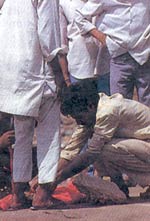A river sutra
A river sutra

A journey down the Yamuna through its course in Delhi may not exactly fit the league of Joseph Conrad's Congo odyssey in his Heart of Darkness, but it does inspire some excitement. My suggestion for undertaking the trip had elicited this response from the editor: "Oh yes, this should be a good time to go. There will be a lot of sewage." The time, incidentally, was June, with the administration indulging in its routine panic over low water levels.
A peek over the Nizamuddin bridge confirmed that there was, indeed, a lot of sewage. I doubted a boat would be able to plough through the semi-solid, inky black mass that passed off for a river. Deciding to give it a shot anyway, I approached an official from the GAP directorate for a boat. I presume he was trying to be funny when he warned me that my family may not want me back after my excursion. "It smells very bad," he explained.
When requests to the DWSSDU drew a similar response, I decided to make my own arrangements. I found several boatmen near the Nigambodh burning ghat, and one of them agreed to take me as far as he could. I was still taking in the rather incongruous sight of 'holy' men saluting the sun with handfuls of sewage when we set off.
The numerous temples, saffron-clad figures and saffron flags along this stretch of the river reminded me once again that this was Yamuna, the Holy River, and not the 'main Delhi nullah it was not long before I felt compelled to cover my nose; shortly thereafter, even covering my nose did not help. The stench was unbearable. As the sun shone down with its usual midsummer relentlessness, the stink seemed to rise in thick clouds from around the boat. Kishan Ram (the boatman) churned the sewage with his oars, not helping the situation very much.
It did not require too much imagination to see that a lot of the stuff floating in the river was untreated. Large islands of water hyacinth flourished along either bank. On the west bank, the very devout were bathing in the river. Orange marigolds, discarded after cremations, floated on the black water. I watched in horrified fascination as men and boys dove into the filth, and emerged spouting out mouthfuls of it. Along the banks of the river, animal carcasses lay entangled in the hyacinth.
Up ahead, the old Yamuna bridge came into view. On either side of the bridge, there were several boys bobbing about with only their heads showing, looking up expectantly at the flyover, waiting for people to throw in the offerings they make to temples. Kishan Ram had had a strange experience while rowing under the bridge a week ago. Somebody threw a rather large bag into the river. As Kishan Ram approached the bag, he was surprised to see something move in it. He pulled it out, and found a six-month-old baby, alive. He took the baby to an orphanage near the river.
Across the bridge, I saw a group of people around a small red parcel on the west bank. This, Kishan Ram said, was where children who died before they were 15 were immersed, since Hindu tradition forbids the cremation of small children. As we rowed past the group, they threw in a plastic bag full of the child's clothes, and several tiny dresses floated out.
As we approached the ITO bridge, fine gray flyash covered the thick black water and the Rajghat power station came into view. A little further down, the ITO barrage made it impossible for us to carry on. Unable to stand the thought of another few hours in the sun and stench, I chose to return by road.
It was not much of a journey, but it provided food for thought. The river obviously still meant a lot to the people who lived around it and worshipped it. How could they keep on ignoring its sorry state?







